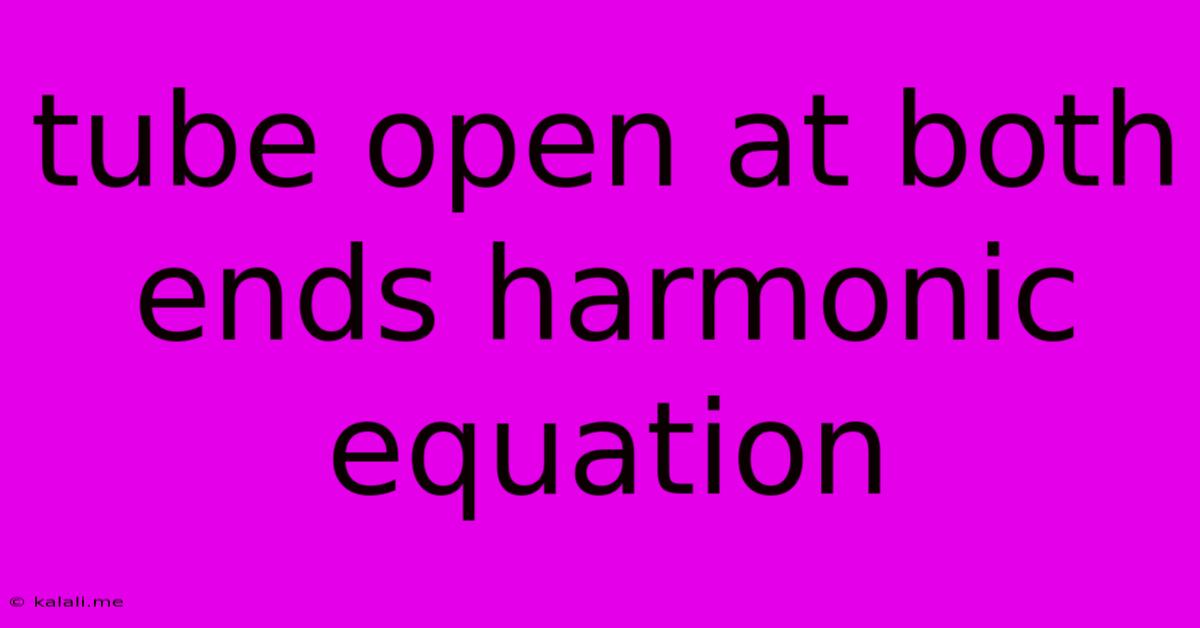Tube Open At Both Ends Harmonic Equation
Kalali
Jun 11, 2025 · 4 min read

Table of Contents
Understanding the Harmonic Equation for Tubes Open at Both Ends
This article delves into the physics behind sound waves in tubes open at both ends, explaining the harmonic equation and its implications. Understanding this equation is crucial for anyone studying acoustics, musical instrument design, or any field involving sound wave behavior in resonant cavities. We will explore the concept of harmonics, nodes, and antinodes, and how they relate to the tube's length and the speed of sound.
The fundamental principle governing the behavior of sound waves in a tube open at both ends is the formation of standing waves. A standing wave is a wave that appears to be stationary, resulting from the interference of two waves traveling in opposite directions with the same frequency and amplitude. In a tube open at both ends, the air molecules at the open ends are free to vibrate with maximum amplitude. This means that the open ends always correspond to antinodes, points of maximum displacement in the standing wave.
Deriving the Harmonic Equation
The simplest standing wave that can form in a tube open at both ends is the fundamental frequency (first harmonic). In this case, the length of the tube (L) is equal to half the wavelength (λ/2) of the sound wave. This is because there's an antinode at each end, with a node in the middle. This relationship can be expressed as:
L = λ₁/2
Where:
- L = Length of the tube
- λ₁ = Wavelength of the fundamental frequency
Since the speed of sound (v) is related to frequency (f) and wavelength (λ) by the equation v = fλ, we can rearrange the equation above to find the fundamental frequency:
f₁ = v / 2L
This gives us the frequency of the fundamental harmonic. Higher harmonics (overtones) are also possible, where the tube contains an integer number of half-wavelengths. The general equation for the nth harmonic is:
fₙ = nv / 2L
Where:
- fₙ = Frequency of the nth harmonic
- n = Harmonic number (1, 2, 3, ...)
- v = Speed of sound
- L = Length of the tube
This equation reveals a crucial characteristic: the frequencies of the harmonics in a tube open at both ends are integer multiples of the fundamental frequency. This is why the harmonics are often referred to as the harmonics series.
Nodes and Antinodes: Visualizing the Standing Waves
Understanding nodes and antinodes is essential for visualizing the standing waves within the tube. Nodes are points of zero displacement (minimum amplitude), while antinodes are points of maximum displacement (maximum amplitude).
- Fundamental Frequency (n=1): One antinode at each open end, with one node in the center.
- Second Harmonic (n=2): Two antinodes and one node in the middle.
- Third Harmonic (n=3): Three antinodes and two nodes.
- And so on...
The pattern continues with each successive harmonic adding another half-wavelength within the tube, resulting in additional nodes and antinodes.
Applications and Considerations
The harmonic equation for tubes open at both ends has numerous applications, particularly in:
- Musical instrument design: Many wind instruments, such as flutes and organ pipes, rely on this principle to produce their characteristic tones. The length and shape of the tube determine the fundamental frequency and the overtones that contribute to the instrument's timbre.
- Acoustics: Understanding resonance in open-ended tubes is critical in architectural acoustics and the design of concert halls.
- Ultrasound: Open-ended tubes are used in certain ultrasound applications to generate and detect sound waves.
While this equation provides a good approximation, several factors can influence the actual frequencies produced, including:
- Temperature: The speed of sound is temperature-dependent.
- End corrections: The open ends of the tube are not perfectly open; the air slightly extends beyond the physical end. This 'end correction' is typically small but can affect the precise frequencies.
- Air pressure: Variations in air pressure will also slightly alter the speed of sound.
This article provides a fundamental understanding of the harmonic equation for tubes open at both ends. By comprehending the relationships between wavelength, frequency, and tube length, you can gain valuable insight into the behavior of sound waves and their applications in various fields. Remember to consider the factors influencing the actual frequencies in real-world scenarios for accurate predictions.
Latest Posts
Latest Posts
-
A Biological Community Of Interacting Organisms And Their Physical Environment
Jun 12, 2025
-
How Many Players Are On A Volleyball Court
Jun 12, 2025
-
What Is The Boiling Temperature Of Ethanol
Jun 12, 2025
-
Rack And Pinion Steering System Diagram
Jun 12, 2025
-
Protein In Breast Milk Per 100ml
Jun 12, 2025
Related Post
Thank you for visiting our website which covers about Tube Open At Both Ends Harmonic Equation . We hope the information provided has been useful to you. Feel free to contact us if you have any questions or need further assistance. See you next time and don't miss to bookmark.